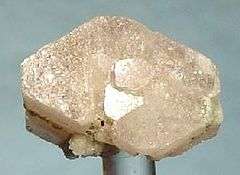Zektzerite
| Zektzerite | |
|---|---|
|
Zektzerite | |
| General | |
| Category | Mineral (Inosilicate) |
| Formula (repeating unit) | LiNa(Zr,Ti,Hf)Si6O15 |
| Strunz classification | 9.DN.05 |
| Crystal system | Orthorhombic |
| Crystal class |
Dipyramidal (mmm) H-M symbol: (2/m 2/m 2/m) |
| Space group | Cmca |
| Identification | |
| Formula mass | 529.66 g/mol |
| Color | Colorless to pink, cream, or white; commonly zoned |
| Crystal habit | Stout pseudohexagonal prisms |
| Cleavage | {100} and {010} perfect |
| Mohs scale hardness | 6 |
| Luster | Vitreous to pearly |
| Streak | White |
| Diaphaneity | Translucent to transparent |
| Specific gravity | 2.79 |
| Optical properties | Biaxial (-) |
| Refractive index | nα = 1.582 nβ = 1.584 nγ = 1.584 |
| Ultraviolet fluorescence | Light yellow |
| References | [1][2][3] |
The mineral zektzerite is a member of the tuhualite group and was first found in 1966 by Seattle mineralogist Benjamin Bartlett "Bart" Cannon. It was discovered in the Willow creek basin below Silver Star mountain in miarolitic cavities within the alkaline riebeckite granite phase of the Golden Horn batholith, Okanogan County, Washington.[2] It is named for Jack Zektzer (born 1936), mathematician and mineral collector of Seattle, Washington.[1]
The mineral was misidentified as alkali beryl (morganite) at that time. Subsequently, in September, 1975, additional specimens of the mineral were found in a float boulder on the north side of Kangaroo Ridge at an approximate elevation of 6500 feet; it was recognized that the material was not beryl.[4]
Properties
Synthesis: by fusion of Li2CO3, Na2CO3, SiO2, ZrO2. The resulting material has a brilliant blue white fluorescence under short wave ultraviolet light.
Occurrence

Zektzerite is a mineral of agpaitic granites with arfvedsonite. It occurs with smoky quartz, microcline, okanoganite, sogdianite, astrophyllite, and zircon. It is found in cavities as euhedral crystals in the agpaitic-granite phase of the Golden Horn batholith, Okanogan County, Washington. It also occurs in blocks of pegmatite as rock-forming grains in a moraine of the Dara Pioz glacier in northern Tajikistan; in the Del Salto pluton in Aysén Province, Chile; Virikkollen, Haneholmveien, Sandefjord, Norway; as euhedral crystals and Ampasibitika, Ampasindava Peninsula, Madagascar. As gemmy crystals up to 3 cm from Mt. Malosa Malawi[3]
References
- 1 2 http://webmineral.com/data/Zektzerite.shtml Webmineral
- 1 2 http://rruff.geo.arizona.edu/doclib/hom/zektzerite.pdf Mineral Handbook
- 1 2 http://www.mindat.org/min-4390.html Mindat
- ↑ Dunn et al.: Zektzerite: a new lithium sodium zirconium silicate related to tuhualite and the osumilite group, American Mineralogist, v. 62, p. 416-20 (1977)
- Die Seltene Mineralien von Dara-i-Pioz in Hochgebirge Tadshikistans Lapis v. 16(12) p. 42-48 (1991)
- Peralkaline rocks in the late Cretaceous Del Salto pluton Eastern Patagonian Andes Aisen Chile Revista Geologica de Chile v. 29 #1 July 1992 p. 3-15
- Glasser, F. P., Marr J. Synthesis of anhydrous silicates containing double chain anions Si6O15 (6-): Proceedings British Ceramic Society No. 28 p. 73-89 June 1979
Guastoni, Alessandro; Pezzotta, Frederico and Zorzi, Frederico: Neufunde aus Alkali Pegmatiten am Mount Malosa Malawi Lapis 3 (2008) p. 38-41
